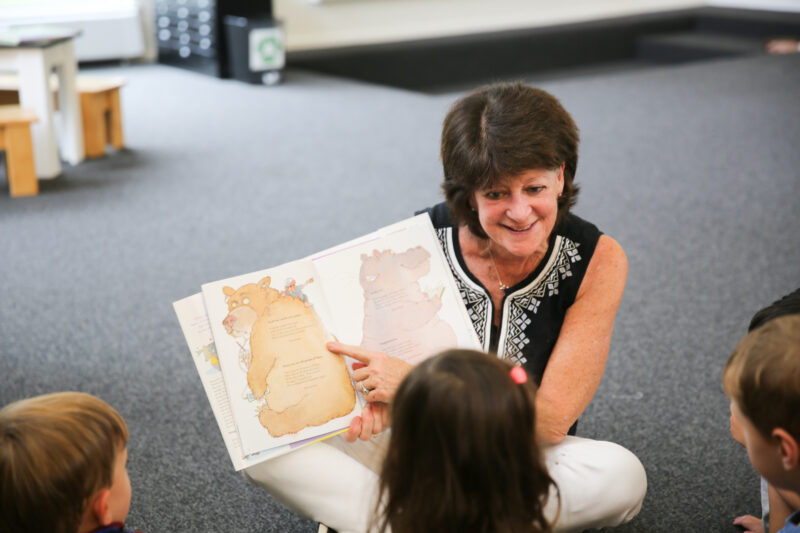As a heartwarming and wonderful first week of school comes to a close, we pause to pay tribute to an author whose love of language and childhood, of words and libraries, equals our own.
I speak of Mary Ann Hoberman, whose mission to elevate the importance of children’s poetry in American culture was fulfilled many times over before her passing in July. Like millions of parents, educators and children who grew up reading the enchanting poetry she penned, TCS mourns the loss of this brilliant and wise writer. At the same time, we want to express our gratitude for Mary Ann’s life and the legacy she left on the pages of more than 50 books, many of which have become favorites of our students and teachers over the years.
Stamford-born and raised, Mary Ann Hoberman was showered with awards because she knew precisely what led children to fall in love with reading and poetry—the power of words and storytelling woven with solid rhythm, rhyme and often clever wordplay. A 1983 National Book Award recognized her now-classic picture book, A House Is a House for Me, for its rollicking text and beautiful illustrations of familiar houses (anthills, dog kennels) and those less so (corn husks and pea pods). Later came the Poetry for Children Award from the National Council of Teachers of English, a Society of School Librarians International Best Book Award and, in 2008, designation as the Children’s Poet Laureate by the Poetry Foundation.
“I want to become a Pied Piper of poetry,” she declared in a newspaper interview about the honor. So, with her customary enthusiasm, she did. Embracing her role as an ambassador for the genre, Mary Ann took her passion to hundreds of thousands of children over the next three years as she traveled the country to read to them in classrooms, libraries and bookstores. As if that weren’t enough, she continued her commitment to promoting literacy, devoting countless hours to Literacy Volunteers while raising four children with her husband in Greenwich, CT.
Although her focus throughout her career was on captivating pre- and early readers, Mary Ann also set her sights as Children’s Poet Laureate on middle school students, who had flocked to her earlier New York Times best-selling literacy series, You Read to Me, I’ll Read to You. “That’s going to be part of my mission … to push poetry for the middle school as well as very young kids,” Mary Ann said. “Poetry gets cut off. It isn’t cool after, say, second or third grade. But they love it when you recite it to older kids and get them to recite it with you.”
Importantly, Mary Ann also saw her new role as an opportunity to right how poetry was being taught in American classrooms, believing that she could restore to children’s poetry its true purpose. “I don’t like it when a four-line poem of mine is in a teacher’s manual, and there are three pages on how to use it across the curriculum and it’s analyzed to death. That is not what poetry is for. It’s for joy.”
In Mary Ann’s capable hands, indeed it was. Read any of her books—The Llama Who Had No Pajama, The Seven Silly Eaters, One of Each—and the telling of an exuberant story in words and lines becomes an adventure featuring clever internal rhymes, unique rhythms gathered from one of her walks, assonance or alliteration. One favorite at TCS, which Robin often reads aloud, is And to Think That We Thought That We’d Never Be Friends. It begins with a squabble between siblings and ends with a whole town marching in a parade and … well, click on the link above, and you will see what Hoberman meant about the joy she sought to convey.
Memories of her own childhood inform much of Hoberman’s poetry, which explains why she was such an exceptional channeler of children’s emotions and sensibilities. “Your childhood is what you’ll draw your work from,” she advised the young writers she taught for decades. “You need to remember what you are now. Look at everything, notice everything, remember all that you can.” Her poem “When I Grow Up” reflects these sentiments perfectly:
When I grow up, I want to be
A grown-up who remembers me
And what it felt like to be small:
How much I liked to bounce a ball
And pump my swing high in the air
And think of flying everywhere …
We especially love Mary Ann Hoberman’s Forget Me Nots, a stunning poetry collection she assembled with great care for younger children. It offers 120 works from classic and contemporary poets and follows her dictum that “there is eye-poetry and there is ear-poetry, but the best poetry provides a feast for both ear and eye” by presenting both childhood favorites and lesser-known treasures. Designed to introduce a range of poetry to the youngest among us, it also encourages them to recite and memorize individual poems using her time-tested tools.
The staff and I cannot think of a better way for our families to start the school year than by diving into Mary Ann Hoberman’s work in the days and months ahead. She understood well that poetry is the perfect medium for nurturing language development and leading children to the cherished moment when reading enthralls. “If my books awaken some children to a love of language, to a sense of the magical qualities in individual words and their combinations, to a feeling that they, too, can make up poems and stories, I am grateful,” Hoberman said. “But even more, I want my books to bring joy and delight to their young readers and listeners—simple joy and delight.”
That she did, for that reason, we won’t forget the unforgettable work and life of Mary Ann Hoberman.
Cheers to an upcoming year filled with the magic of words, poems and stories.
Maureen

